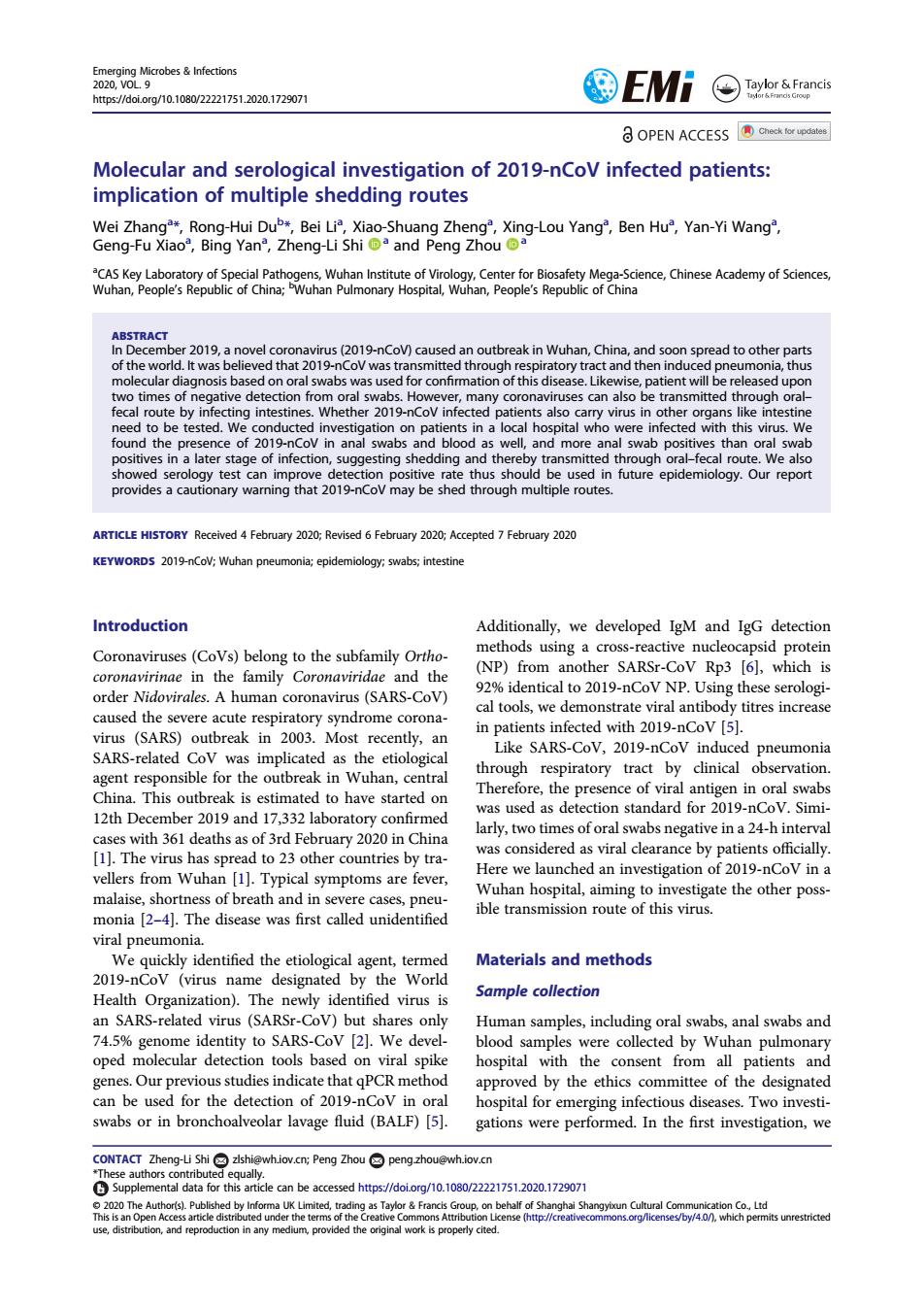正在加载图片...

i.org/10.1080/2221751.2020.1729071 ®EMi Taylor&Franc OPEN ACCESS Molecular and serological investigation of 2019-nCoV infected patients: implication of multiple shedding routes ABSTRACT ad to aseotedth e by r2019 in a latece of e of infection gmtedthrd hafecalTout9 We als can im iology.Our repo ARTICLE HISTORY Received 4 February 2020:Revised 6 February 2020:Accepted 7 February 2020 KEYWORDS 2019-nCoV:Whanm Introduction methods using a cross Coronaviruses(CoVs)belong to the subfamily Ortho psid protein (NP)from another SARSr-CoV Rp3 [6],which is orderN lto 2019-nCov NP.Using these serologi coronaviru S-CoV y titres increas Like SARS CoV 2019-nCov induced SARS related cov was imnlicated as the agent responsible for the outbreak in Wuhan,central through respiratory tract by clinical observation d to have started on Therefore,the presence of swab d as dete for 20 19-1 20200n arly,tw e ive in vellers from Wuhan [1].Typical symptoms are fever Here we launched an investigation of 2019-nCoV in a Wuhan hospital,aiming to investigate the other poss- ible transmission route of this virus identified the etiological Materials and methods 2019-nCov (virus name Health Organization).The newly identified virus is Sample collection anSARS-related virus (SARS -Cov)bu sh res only Human samples,including oral swabs,anal swabs and 2 de ere collectec by Wuhan pulmonar .Our previous studies indicate that aPCR method can be used for the detection of 2019-ncov in ora hospital for eme infectious diseases two investi. swabs or in bronchoalveolar lavage fluid (BALF)[5]. can be accessed http //10,1080/22221751.2020.172907 Molecular and serological investigation of 2019-nCoV infected patients: implication of multiple shedding routes Wei Zhanga *, Rong-Hui Dub *, Bei Lia , Xiao-Shuang Zhenga , Xing-Lou Yanga , Ben Hua , Yan-Yi Wanga , Geng-Fu Xiaoa , Bing Yana , Zheng-Li Shi a and Peng Zhou a a CAS Key Laboratory of Special Pathogens, Wuhan Institute of Virology, Center for Biosafety Mega-Science, Chinese Academy of Sciences, Wuhan, People’s Republic of China; b Wuhan Pulmonary Hospital, Wuhan, People’s Republic of China ABSTRACT In December 2019, a novel coronavirus (2019-nCoV) caused an outbreak in Wuhan, China, and soon spread to other parts of the world. It was believed that 2019-nCoV was transmitted through respiratory tract and then induced pneumonia, thus molecular diagnosis based on oral swabs was used for confirmation of this disease. Likewise, patient will be released upon two times of negative detection from oral swabs. However, many coronaviruses can also be transmitted through oral– fecal route by infecting intestines. Whether 2019-nCoV infected patients also carry virus in other organs like intestine need to be tested. We conducted investigation on patients in a local hospital who were infected with this virus. We found the presence of 2019-nCoV in anal swabs and blood as well, and more anal swab positives than oral swab positives in a later stage of infection, suggesting shedding and thereby transmitted through oral–fecal route. We also showed serology test can improve detection positive rate thus should be used in future epidemiology. Our report provides a cautionary warning that 2019-nCoV may be shed through multiple routes. ARTICLE HISTORY Received 4 February 2020; Revised 6 February 2020; Accepted 7 February 2020 KEYWORDS 2019-nCoV; Wuhan pneumonia; epidemiology; swabs; intestine Introduction Coronaviruses (CoVs) belong to the subfamily Orthocoronavirinae in the family Coronaviridae and the order Nidovirales. A human coronavirus (SARS-CoV) caused the severe acute respiratory syndrome coronavirus (SARS) outbreak in 2003. Most recently, an SARS-related CoV was implicated as the etiological agent responsible for the outbreak in Wuhan, central China. This outbreak is estimated to have started on 12th December 2019 and 17,332 laboratory confirmed cases with 361 deaths as of 3rd February 2020 in China [1]. The virus has spread to 23 other countries by travellers from Wuhan [1]. Typical symptoms are fever, malaise, shortness of breath and in severe cases, pneumonia [2–4]. The disease was first called unidentified viral pneumonia. We quickly identified the etiological agent, termed 2019-nCoV (virus name designated by the World Health Organization). The newly identified virus is an SARS-related virus (SARSr-CoV) but shares only 74.5% genome identity to SARS-CoV [2]. We developed molecular detection tools based on viral spike genes. Our previous studies indicate that qPCR method can be used for the detection of 2019-nCoV in oral swabs or in bronchoalveolar lavage fluid (BALF) [5]. Additionally, we developed IgM and IgG detection methods using a cross-reactive nucleocapsid protein (NP) from another SARSr-CoV Rp3 [6], which is 92% identical to 2019-nCoV NP. Using these serological tools, we demonstrate viral antibody titres increase in patients infected with 2019-nCoV [5]. Like SARS-CoV, 2019-nCoV induced pneumonia through respiratory tract by clinical observation. Therefore, the presence of viral antigen in oral swabs was used as detection standard for 2019-nCoV. Similarly, two times of oral swabs negative in a 24-h interval was considered as viral clearance by patients officially. Here we launched an investigation of 2019-nCoV in a Wuhan hospital, aiming to investigate the other possible transmission route of this virus. Materials and methods Sample collection Human samples, including oral swabs, anal swabs and blood samples were collected by Wuhan pulmonary hospital with the consent from all patients and approved by the ethics committee of the designated hospital for emerging infectious diseases. Two investigations were performed. In the first investigation, we © 2020 The Author(s). Published by Informa UK Limited, trading as Taylor & Francis Group, on behalf of Shanghai Shangyixun Cultural Communication Co., Ltd This is an Open Access article distributed under the terms of the Creative Commons Attribution License (http://creativecommons.org/licenses/by/4.0/), which permits unrestricted use, distribution, and reproduction in any medium, provided the original work is properly cited. CONTACT Zheng-Li Shi zlshi@wh.iov.cn; Peng Zhou peng.zhou@wh.iov.cn *These authors contributed equally. Supplemental data for this article can be accessed https://doi.org/10.1080/22221751.2020.1729071 Emerging Microbes & Infections 2020, VOL. 9 https://doi.org/10.1080/22221751.2020.1729071